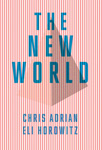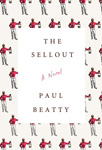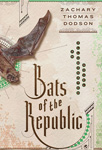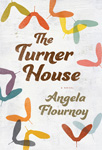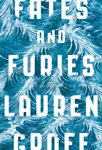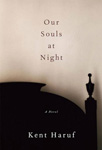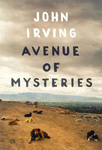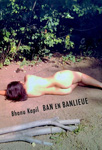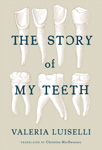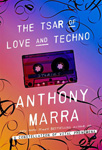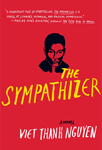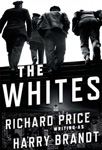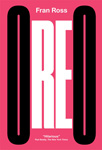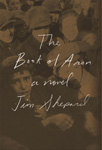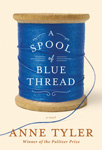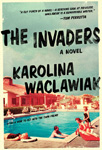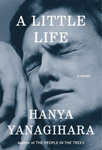by Chris Adrian and Eli Horowitz
Buy it at Powell’s »Miriam Tuliao: Like Ana Mendieta and Theresa Hak Kyung Cha, British-Indian artist Bhanu Kapil’s writings are experimental and her view of the world, woman-centered. Kapil’s latest work, Ban en Banlieue, is performance-based and genre-crossing, blending prose, photography, and free verse—with a particular emphasis on free—including seemingly random jottings, ideas, meditations, fragmentary observations, and, as the artist states, a string of “schizophrenic sentence[s].”
“Radical modernity requires something of me,” explains Kapil as she revisits early memories of a protest turned race riot in the spring of 1979 in an immigrant suburb outside of London. “Everyone’s indoors. Everyone can tell what’s coming,” she writes, recalling the boarded glass, the drawn curtains, and her 10-year-old self finding shelter “between the hand-sewn quilts shipped from India.” Kapil projects a sobering scene:
Think of the sky. Think of the clear April day with its cardigans and late afternoon show. Think of the indigo sky lowering over London like a lid. Think of Blair Peach, the anti-racism campaigner and recent emigrant from New Zealand, who will die before this day is out.
Kapil is deeply connected to the experience of communities of color and fearlessly considers big social issues including violence against women. In notes for a performance, she memorializes the December 2012 death of Joyti Singh Pandey, a young girl who, returning from the cinema in New Delhi, was gang raped, thrown from a bus, and left to die. A haunted Kapil disturbingly relates, the girl “lay on the ground for 40 minutes—twitching—making low sounds—then none at all—diminishing—before anyone called the police. I thought about those 40 minutes.”
Cha-Cha, one of the patriarchal figures in The Turner House, experiences hauntings of a different sort. Flournoy’s debut novel opens in the Detroit summer of 1958: “The eldest of six of Francis and Viola Turner’s thirteen children claimed that the big room of the house on Yarrow Street was haunted for at least one night. A ghost—a haint, if you will—tried to pull Cha-Cha out of the big room’s second-story window.” While the “gangly-legged, croaky-voiced” 14-year-old Cha-Cha triumphantly survives the attack, decades later, the “blue light, that familiar, flickering, and fear-inducing blue from the big room, fill[s] his cab” in a Chicago storm and veers him off the highway. “His old haint had found him and almost destroyed him in a matter of seconds.”
Like Ban en Banlieue, The Turner House explores the lives of women (“A woman without no options is waitin for a man to come by and ruin her,” Viola, the aging African-American family matriarch, reminds her daughters) and nostalgically considers memories of place. Of the old Turner house:
Dozens of brown outlines on the yellow wallpaper—ovals and rectangles—highlighted where picture frames once hung. Not long ago, every descendant of Francis and Viola Turner smiled from the front room’s walls. Four generations, nearly one hundred faces. Some afro’d, some Jheri curled, some bald, more balding. Mortarboards, nurses’ scrubs, swelling bellies, and wedding tulle. A depression in the floorboards opposite the front door marked the spot where Viola’s armchair had stood. Lelah had spent whole afternoons on the floor in front of that chair, watching the comings and goings of Yarrow Street as her mother or an older sister greased her scalp and combed her hair. The memory made her feel safe for a moment, like maybe she’d made the right choice coming back here.
As a public librarian, I’ve come to believe, understand, and accept that there truly is a book for every reader. For this reason, I’m convinced that despite the fact that The Turner House and Ban en Banlieue are structurally and stylistically distinct (the former being a lyrical novel and the latter a radical poetic work, requiring readers, present company included, to assume a different approach and attitude) both books deserve a wide readership not only for their contemplative and compelling voices, but most especially for their thought-provoking and poetic passages. Kapil’s narrator daringly (perhaps, a bit accusatorially) asks, “Are you alive?” while one of Flournoy’s principal characters raises the question, “Can a human being ever truly know another person’s heart?” It is this singularly understated, elegant song of a line that tipped the scale for me as a reader. With Ban en Banlieue, I sought (desperately, at times) to connect with the book’s fractional lines, utterances, and declarations—while throughout The Turner House, I found and embraced the comfort of home.
Match Commentary
By Christopher Hermelin & Drew Broussard
Drew: Ooooh, it’s swanky in here. Did you see the full-service soda fountain and grill over by the window?
Christopher: I wish you didn’t have to reach through the grill flames to turn on the soda fountain though. That’s some strange design.
Drew: Indeed. I’m gonna need a new shirt before we leave.
Christopher: We should probably introduce ourselves. We’re the hosts of So Many Damn Books, a twice-monthly podcast that celebrates reading and ridiculously large TBR piles. We started the show because new male friendships in your post-early-20s can feel like dating without a project to focus on.
Drew: It probably didn’t help (or it did? I don’t know) that the first time we met in person, at the Tournament of Books 10th Anniversary Party, I was dressed as a rooster. Regardless of that, we owe our show AND friendship to the ToB.
Christopher: Living proof that you don’t only make enemies in the comment section.
Drew: It’s true! If you listen to us, which you can do here on iTunes or via our website, you’ll see that we really do a nice job of pretending to not hate each other’s opinions on books. Speaking of: Let’s give said opinions about these books!
Christopher: If we must. Before we started self promoting, we were talking about strange design, and Ban en Banlieue is strange by design. It’s a very unsettling feeling to read an intimate book of someone’s deepest thoughts and still feel on the outside.
Drew: Agreed. The reading experience, for me, was constantly being aware of the absence of the thing that we’re ostensibly looking for, like when people use the dip in a star’s output to discover new planets. We never see the planet; we see everything but the planet. That’s how I felt with Ban, like I saw everything but the actual story she was hypothetically trying to tell—except, by some strange alchemy, I still ended up with a sense of that story, even if I couldn’t see it clearly.
Christopher: Nice simile with the planets. Topical. I think that negative space was purposeful. Kapil calls it a “failed novel” for a reason, and I think it’s because her narrator seems trapped, like if she could just capture exactly what it is she’s feeling, perhaps in a “successful” novel, she would be freed from this horrifying event that haunts her. Both of these books are, in some ways, about obsession (well, all books are, but these two are particularly obsessed with obsession). Perhaps it was merciful of her to write about/around that obsession rather than finding the root of how that obsession grew—it kept it hermetically sealed.
Because I kept on trying to figure out why she was using the different forms she was using rather than feeling what she was feeling, part of me worried that I would have made the same judgment as Tuliao, coming from a less-than-educated understanding of the text. The Turner House is so much more of a traditional contemporary novel, and I know my way around those.
Drew: One of my favorite things about the tournament is that it always directs us toward books that we might’ve missed—and that those books, quite often, challenge our perception of what makes a novel. Ban definitely does that and I’m not even sure I would call it a novel. I found mine in the poetry section of the bookstore, which makes a certain amount of sense to me, as it fits in nicely with form-busting collections like Claudia Rankine’s Citizen: An American Lyric and Saul Williams’s US(a.). Not only are we being challenged about whether or not this is a novel, we’re being challenged as to whether or not it fits any existing structure.
But I’m with you on why I would’ve made the same judgement, from a less-open place: I’m a sucker for big family novels and The Turner House is a stellar entry in that canon. Who says traditional is a bad thing, you know?
Christopher: Well, you know, Nightboat (the publisher of Ban en Banlieue) doesn’t even call it a novel. On the flap, it says Prose/Poetry. So it isn’t a novel, or fiction, it’s something else, something that bucks tradition. When you decide to leave traditional forms behind, I think you know you’re going to end up leaving behind traditional responses to your text. So that opens up the question, what do I want from reading? What response am I hoping to have? That’s a hard question to answer, generally, but I had my answer in the other book in the matchup. The Turner House is stellar. It’s the book I wouldn’t have read if it weren’t for the tournament, which makes me feel even more warmly toward it, and it stands as a great explanation of why we use the traditional forms.
Drew: I was thinking about this as I was working on my review of the book: The Turner House, traditional as it may be, also subverts some expectations. When a novel (or any piece of creative output, frankly) is set in Detroit, I immediately assume that there’s going to be some element of “this city is destroyed” to the proceedings and there really wasn’t, here. Yes, the titular house is in trouble and there’s discussion of neighborhoods in general failing, but Flournoy treats the city like a real city where people still live, as opposed to something effectively lost to us. I appreciated that.
Christopher: OK, so if I’m reading you correctly, you’re saying that The Turner House subverted your expectation for Detroit to be treated poorly? I guess I haven’t read much set in contemporary Detroit.
Drew: I’m thinking of Lauren Beukes’s last two novels, of Lisa D’Amour’s great play Detroit, even of a film like Jarmusch’s Only Lovers Left Alive (these are just the few that come right to mind) and the way that they show Detroit as ruined. It’s a city that has all but collapsed. But to the characters in The Turner House, Detroit is ordinary, in a way that we might consider wherever any of us live to be ordinary. To me, this was just as exciting as the genuine engagement in an otherwise traditionally realist novel with the reality of Cha-Cha’s haint—with the reality of haints at all, even.
Christopher: I don’t think “traditional novel” means that expectations aren’t subverted. It just means, to me, that setting, character, and forward action are all consistently addressed. Ban wasn’t interested in forward action and climaxes; Turner was. An expectation I had that I’m glad Flournoy subverted was Lelah’s gambling—I thought for sure she was going to win enough to buy the house. Luckily, Flournoy is interested in more than cheap emotional payoffs. Her best choice was to enter so many different heads over the course of the book. It made for many nice moments in which she could explore how people in the same family can have different, logical perspectives. One that immediately springs to mind is Cha-Cha’s house being one level so there won’t be stairs to navigate in old age. Troy, not knowing that information, wonders about the cost-effectiveness of heating a house with a rambling single story footprint. This is the sort of empathy that the best fiction inspires, that just because you can’t see someone’s logic, doesn’t mean that there wasn’t logic applied. It’s also the less showy version of what Groff was possibly working toward in Fates and Furies, when we learn Mathilde’s side of things.
Drew: Oh, man, too soon. I still can’t even think about Fates and Furies without remembering that it’s out. (But also, you’re totally right: This book has a big beating heart and it invites the reader to share, to become a part of the family for a little while.)
Christopher: Maybe that’s where the divide shows up for Fates and Furies—people don’t like feeling the rug pulled out from under them so completely. Regardless, with all that Flournoy is up to, and everything she does so elegantly, I’m glad to see it moving on.
Drew: Ditto. I hope to see it make a real run at the Rooster. And whether or not it does, we’ll see you all in the comments / on the airwaves. Now, important question: Do you think we get to take these mugs home with us?
Christopher: I don’t know what you’re talking about. There were never any mugs here, and I always had these mug-shaped tumors on my stomach that are too disgusting to show anyone. Let’s go.

The official 2016 Tournament of Books T-Shirt by book designer Janet Hansen. Order yours!


